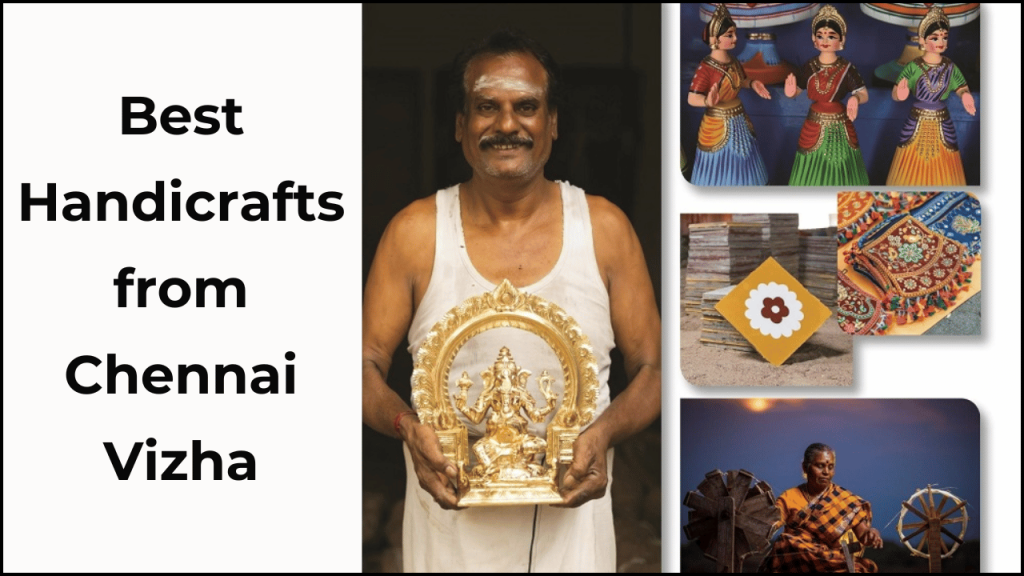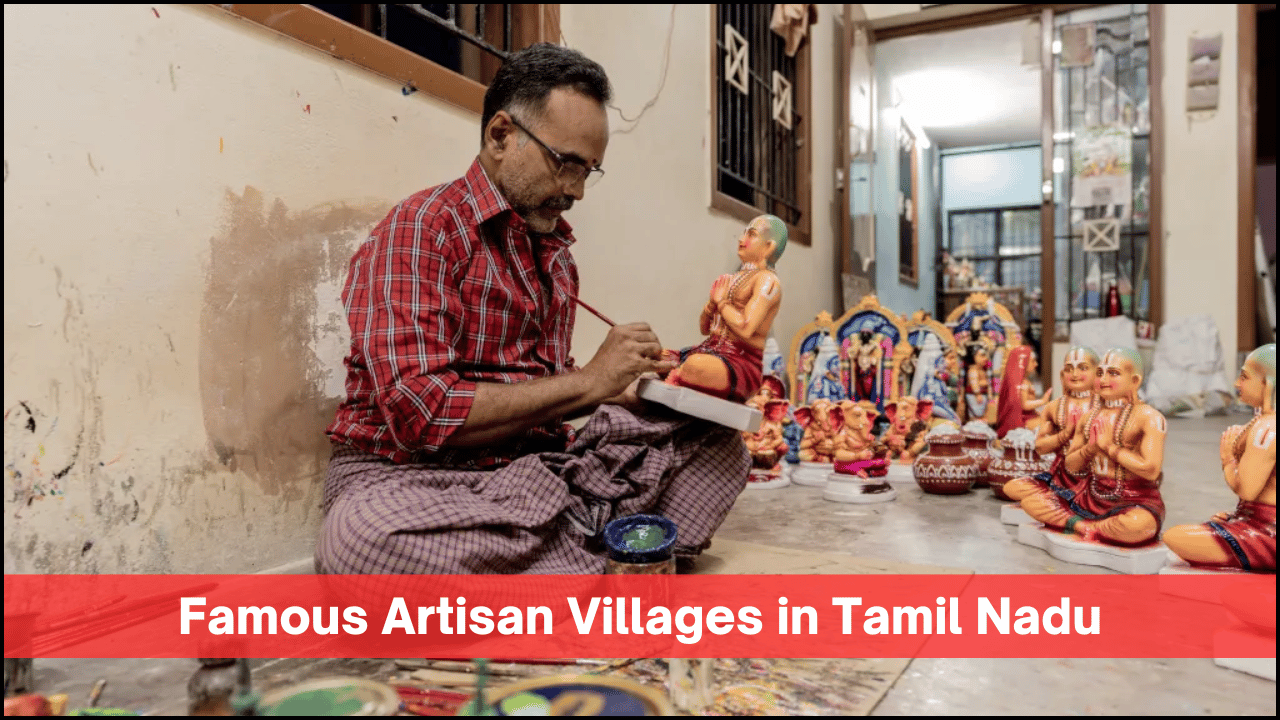
Chennai Vizha celebrates the culture, traditions, and creativity of Tamil Nadu. One of the main attractions of this grand festival is the wide variety of handicrafts. Every year, local artisans from different parts of Tamil Nadu come together to display and sell their beautiful handmade products. Each item reflects the local community’s rich heritage, traditional techniques, and talent.
Below is a detailed look at the best handicrafts that were showcased in various editions of Chennai Vizha:
Table of Contents
Key Highlights of Handicrafts at Chennai Vizha
- Handcrafted items from across Tamil Nadu
- Use of natural, eco-friendly materials
- Traditional art combined with modern designs
- Live demonstration by local artisans
- Affordable pricing and wide variety
- Support for local cottage industries
Top Handicrafts from Chennai Vizha
1. Tanjore Paintings
- Tanjore painting is a classical South Indian art form.
- Paintings have gold foil work and bright colors.
- Gods and goddesses are commonly featured.
- Wooden panels are usually used for this art.
- Artisans explained the meaning and story behind each painting.
2. Kalamkari Art
- Kalamkari art uses natural dyes and hand painting.
- Cotton or silk fabric is the base.
- Themes from mythology and nature are common.
- Hand-painted sarees and wall hangings were displayed.
- Visitors appreciated the detailed brushwork.
3. Stone Carvings
- Stone sculptures of gods and temple figures were showcased.
- Granite and soapstone were the main materials.
- Fine detailing showed the skill of the sculptors.
- Medium to large-sized sculptures were available.
- Some stalls even had mini temples and decorative pieces.
4. Bronze Idols
- Bronze casting followed the ancient ‘lost wax’ technique.
- Idols of Nataraja, Ganesha, and Shiva were most popular.
- Each piece was handcrafted and unique.
- Artisans explained the casting process in simple steps.
5. Terracotta Items
- Pots, lamps, figurines, and wall hangings were displayed.
- Terracotta art came from regions like Villianur and Cuddalore.
- Earthenware had both traditional and modern patterns.
- Affordable pricing made it a favorite among buyers.
Handicrafts and Their Details
| Handicraft Type | Material Used | Region Known For It | Pots, lamps, and wall décor |
|---|---|---|---|
| Tanjore Paintings | Sarees, dupattas, and scarves | Thanjavur | Religious paintings |
| Kalamkari Art | Cotton, natural dyes | Srikalahasti, Andhra border | Sarees, dupattas, scrolls |
| Stone Carvings | Granite, soapstone | Mamallapuram | Deity idols, temple models |
| Bronze Idols | Bronze, wax, clay | Swamimalai | Nataraja idols, traditional statues |
| Terracotta Items | Clay | Villianur, Cuddalore | Pots, lamps, wall décor |
6. Palm Leaf Products
- Palm leaf baskets, mats, and folders were available.
- Items were 100% natural and eco-friendly.
- Artists used intricate weaving patterns.
- Palm leaf books with religious scripts were also sold.
7. Jute Crafts
- Bags, wallets, and table runners made of jute were displayed.
- Crafts were strong and durable.
- Most stalls used colored jute threads for design.
- Young visitors loved the trendy look of these items.
8. Bamboo and Cane Items
- Bamboo chairs, baskets, and lamps were on display.
- Cane trays and fruit bowls were also present.
- Crafts came mainly from Nilgiris and nearby forests.
- Lightweight and elegant, these pieces attracted many buyers.
Live Demonstrations by Artisans
- Skilled artists gave live demos at many stalls.
- Visitors watched the Tanjore painting creation step-by-step.
- Sculptors showed how raw stone turned into beautiful idols.
- Weavers used handlooms to create cotton mats and sarees.
- Potters shaped clay into diyas, bowls, and decorative pieces.
Live Demo Highlights
| Craft Type | Demo Activity Shown | Visitor Response |
|---|---|---|
| Tanjore Painting | Gold foil application | Very positive, engaging |
| Pottery | Kids enjoyed it a lot | Kids enjoyed a lot |
| Weaving | Traditional handloom setup | Educational experience |
| Sculpture | Carving tools in action | Admired skill and patience |
| Palm Weaving | Basket weaving with palm leaves | Very interactive |
Support for Local Artisans
- Chennai Vizha provided stalls free or at low cost.
- Government bodies helped promote handmade products.
- NGOs and self-help groups also participated.
- Sales helped increase income for rural artisans.
- Direct interaction built trust with buyers.
Handicrafts as Souvenirs
- Many visitors bought handicrafts as gifts and souvenirs.
- Products were light and easy to carry.
- Cultural values made them unique and meaningful.
- Tourists especially preferred hand-painted items.
Packaging and Presentation
- Most stalls used eco-friendly paper or cloth bags.
- Labels included artisan names and the village of origin.
- Tags shared care instructions and making details.
- A good presentation added to the product value.
Impact of Chennai Vizha on Handicrafts
- The festival created awareness of traditional art forms.
- Handicrafts received wider recognition and media coverage.
- Youth showed interest in learning these crafts.
- Orders increased from shops and online platforms.
- Revival of fading art forms took place due to such platforms.
In Summary
Chennai Vizha is a cultural event and a strong support system for local handicrafts. Handicrafts from this festival reflect Tamil Nadu’s history, talent, and creativity. Each product carries the hard work and passion of the artisan who made it. Visitors to the festival get a chance to see, touch, and understand the true beauty of handmade items. These handicrafts are more than just products—they are stories, traditions, and living art.
By promoting these crafts, Chennai Vizha not only preserves tradition but also empowers communities and inspires the next generation to keep the legacy alive.





